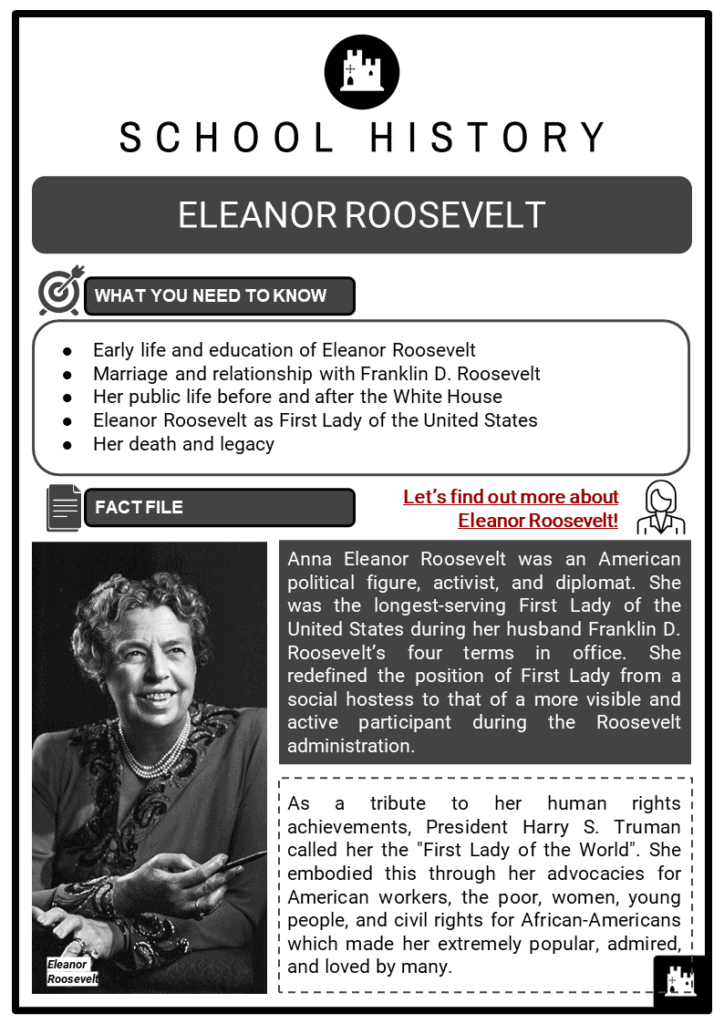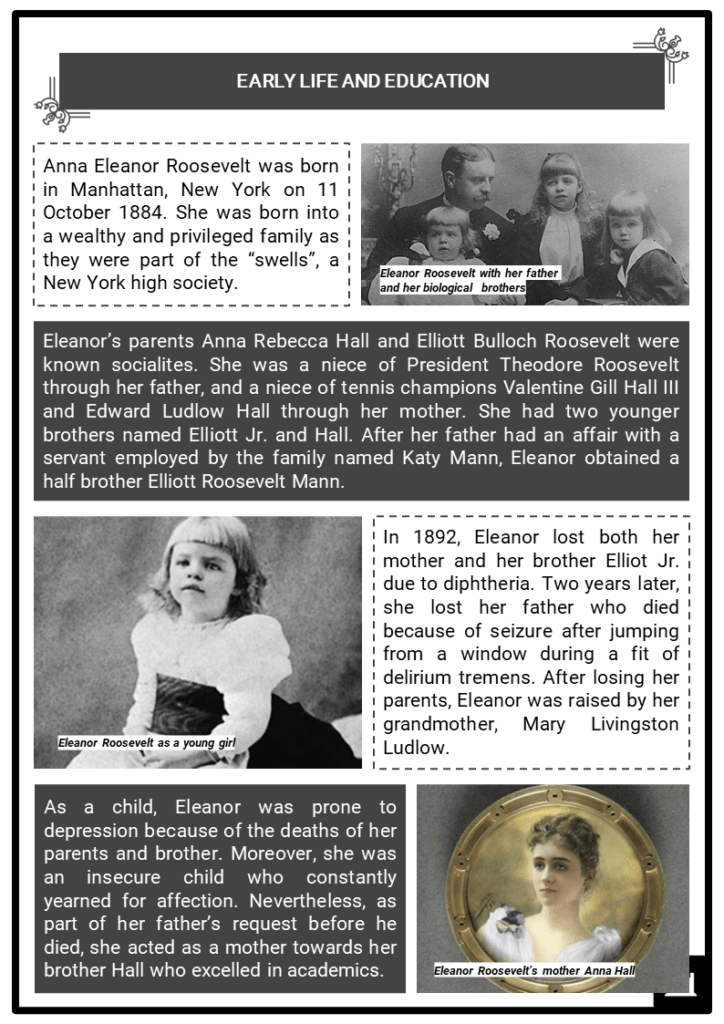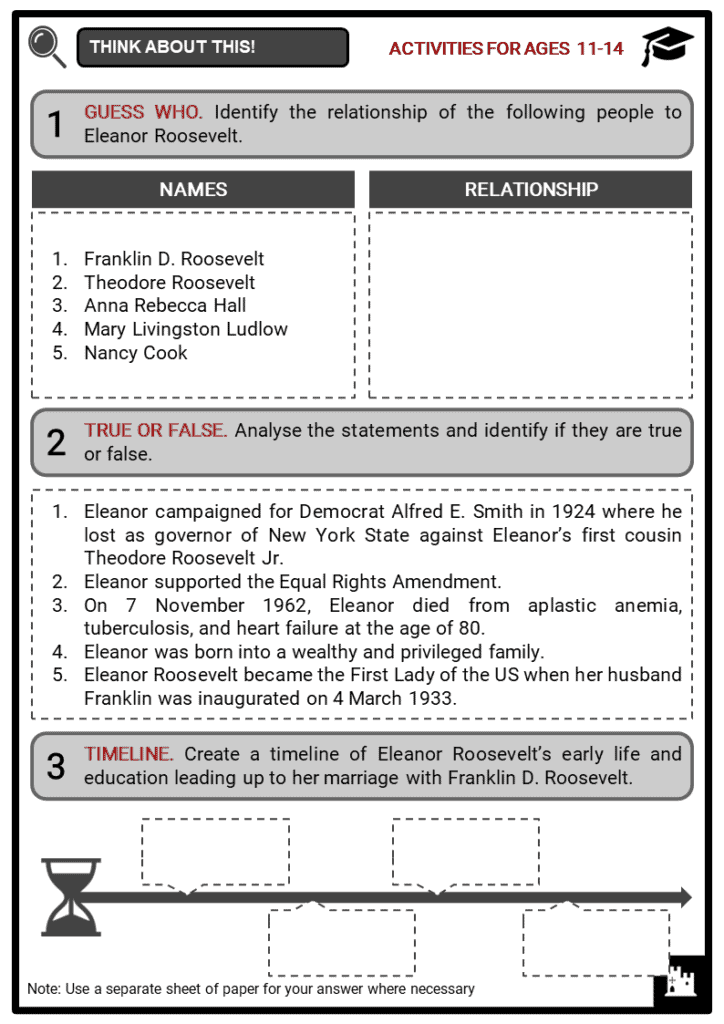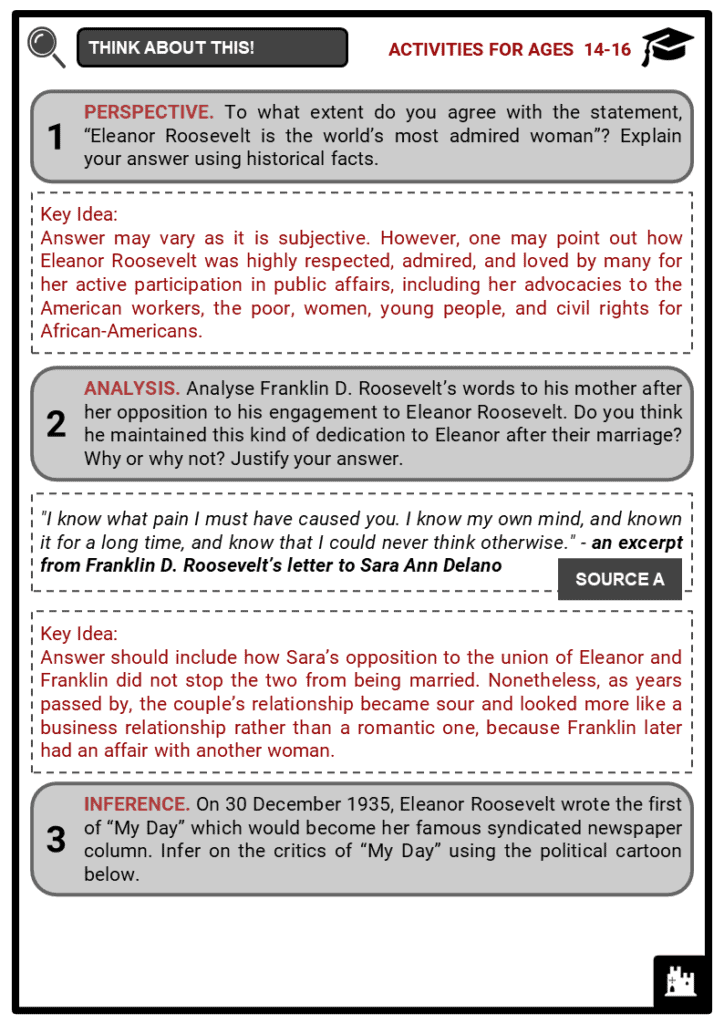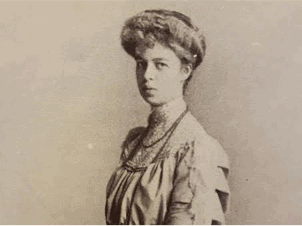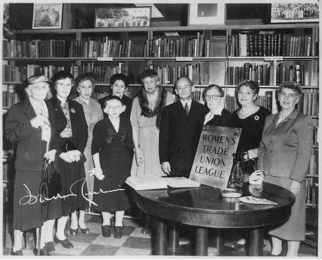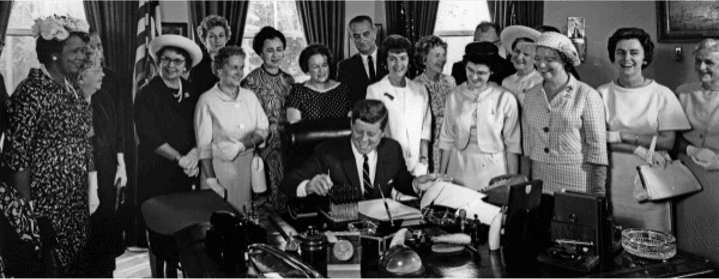Download Eleanor Roosevelt Worksheets
Do you want to save dozens of hours in time? Get your evenings and weekends back? Be able to teach Eleanor Roosevelt to your students?
Our worksheet bundle includes a fact file and printable worksheets and student activities. Perfect for both the classroom and homeschooling!
Table of Contents
Add a header to begin generating the table of contents
Summary
- Early life and education of Eleanor Roosevelt
- Marriage and relationship with Franklin D. Roosevelt
- Her public life before and after the White House
- Eleanor Roosevelt as First Lady of the United States
- Her death and legacy
Key Facts And Information
Let’s find out more about Eleanor Roosevelt!
- Anna Eleanor Roosevelt was an American political figure, activist, and diplomat. She was the longest-serving First Lady of the United States during her husband Franklin D. Roosevelt’s four terms in office. She redefined the position of First Lady from a social hostess to that of a more visible and active participant during the Roosevelt administration.
- As a tribute to her human rights achievements, President Harry S. Truman called her the "First Lady of the World". She embodied this through her advocacies for American workers, the poor, women, young people, and civil rights for African-Americans which made her extremely popular, admired, and loved by many.
Early Life And Education
- Anna Eleanor Roosevelt was born in Manhattan, New York on 11 October 1884. She was born into a wealthy and privileged family as they were part of the “swells”, a New York high society.
- Eleanor’s parents Anna Rebecca Hall and Elliott Bulloch Roosevelt were known socialites. She was a niece of President Theodore Roosevelt through her father, and a niece of tennis champions Valentine Gill Hall III and Edward Ludlow Hall through her mother. She had two younger brothers named Elliott Jr. and Hall. After her father had an affair with a servant employed by the family named Katy Mann, Eleanor obtained a half brother Elliott Roosevelt Mann.
- In 1892, Eleanor lost both her mother and her brother Elliot Jr. due to diphtheria. Two years later, she lost her father who died because of seizure after jumping from a window during a fit of delirium tremens. After losing her parents, Eleanor was raised by her grandmother, Mary Livingston Ludlow.
- As a child, Eleanor was prone to depression because of the deaths of her parents and brother. Moreover, she was an insecure child who constantly yearned for affection. Nevertheless, as part of her father’s request before he died, she acted as a mother towards her brother Hall who excelled in academics.
- Eleanor was tutored privately at first through the guidance of her aunt, Anna “Bamie” Roosevelt. At the age of 15, she was sent to Allenswood Academy in Wimbledon, England. Though she was loved by everybody at Allenswood and she wished to continue her studies there, she was asked by her grandmother to come home to the United States to make her social debut in 1902 at a debutante ball at the Waldorf-Astoria hotel.
Marriage And Relationship With Franklin D. Roosevelt
- In 1902 on a train to Tivoli, New York, Eleanor Roosevelt met Franklin Delano Roosevelt, her father’s fifth cousin. They developed a romantic relationship and became engaged the following year on 22 November.
- Sara Ann Delano, Franklin’s mother, opposed the union and took her son to a cruise hoping that being separated from Eleanor would extinguish the romance. This failed as the couple remained determined to wed.
- On 17 March 1905 at their family estate in Newburgh named Algonac, Eleanor and Franklin were finally married. The wedding became front page in newspapers, including the New York Times, as President Theodore Roosevelt had attended the ceremony. When he was asked what he felt about the union of two Roosevelts he answered, "It is a good thing to keep the name in the family”.
- After the wedding, the newlywed couple went on their formal honeymoon on a three-month tour of Europe. They returned to the US afterwards, settling at a townhouse in New York City provided by Sara.
- From the start, Eleanor struggled with her relationship to her mother-in-law as she was controlling. Despite her later admitting to Franklin that she did not like to live in a house which was not in any way hers, little had changed in her relationship with Franklin’s mother. Sara continued to meddle with the couple’s life, even telling her six grandchildren that she was more a mother to them than Eleanor would ever be.
- In 1918, Eleanor found out her husband was having an affair with Lucy Mercer, her social secretary. Though she offered him a divorce, Franklin chose to stay as a divorce would hurt his political career. When Franklin achieved success in politics, Eleanor devoted herself to public service while working for the American Red Cross during World War I. In addition, when Franklin suffered a polio attack in 1921, he relied heavily on Eleanor for physical assistance.
Eleanor Before The White House
- During the 1920 presidential election, Democratic candidate James M. Cox chose Franklin to be his running mate. Eleanor Roosevelt made her first campaign appearances as Franklin toured the country for the campaign. Despite their efforts, however, they were defeated.
- During the onset of Franklin’s polio attack, Eleanor began making public appearances on behalf of her husband. She started working with the Women’s Trade Union League (WTUL) to raise funds in support of the union’s goals. Throughout all these, she became a highly influential leader, winning the support of many people.
- Eleanor also campaigned for Democrat Alfred E. Smith in 1924 where he won as governor of New York State against Eleanor’s first cousin Theodore Roosevelt Jr. By 1928, she was promoting Smith’s presidential candidacy as well as Franklin’s candidacy for governor of New York. Despite Smith losing, Franklin won and they moved into the governor’s mansion. Eleanor, fully committed to support her husband, traveled widely in the state on behalf of Franklin.
- In 1927, Eleanor and her friends Marion Dickerman and Nancy Cook bought the Todhunter School for Girls where she taught upper-level courses. Moreover, they (with the addition of Caroline O’Day) also established the Val-Kill Industries to provide supplemental income for local farming families. Eventually, in order to commemorate her life and work as an outstanding woman in American history, the surrounding property of the Val-Kill Industries was designated as the Eleanor Roosevelt National Historic site.
First Lady Of The United States
- Eleanor Roosevelt became the First Lady of the US when her husband Franklin was inaugurated on 4 March 1933.
- She was reluctant and depressed at having to assume the role as First Lady, however, with the support from Louis Howe and Lorena Hickok, she set out to redefine the position from a conventional role of social hostess to that of a more visible and active participant in the Roosevelt administration. She was the first ‘First Lady’ to hold regular press conferences and the first to speak at a national party convention.
- In her twelve years in the White House, she frequently travelled to make personal appearances at labour meetings to assure those workers who have suffered during the Great Depression era that the White House was mindful of their predicament.
- In early 1933, she went to visit the protest group of World War I veterans called ‘Bonus Army’ that sought for their veteran bonus certificates to be awarded early. During World War II, she traveled abroad to visit US troops.
- Aside from being an advocate for American workers, the poor, women, and young people, she also devoted herself to civil rights for African-Americans. She supported the civil rights movement and the anti-lynching bill, causing a bad relationship with white supremacist groups.
- Moreover, her resignation from the Daughters of the American Revolution (DAR) was significant to the cause of the movement since it barred an African-American singer from performing at its Constitution Hall in Washington, D.C. She served the role of First Lady until her husband's death on 12 April 1945.
Eleanor After The White House
- After the death of the president, Eleanor Roosevelt returned to New York. Instead of running for public office, she chose to remain as a highly active private citizen. She served as a US delegate to the United Nations (UN) from 1946 to 1953. In 1948, as an advocate of human rights, she delivered her most famous speech titled, “The Struggle for Human Rights”. This urged UN members to vote to pass the Universal Declaration of Human Rights.
- On 14 December 1961, then-President John F. Kennedy signed Executive Order 10980, which created the President's Commission on the Status of Women (PCSW) which was headed by Eleanor. The commission was established to address issues regarding the status of women.
- One of the most pressing concerns at the time was women’s experiences in labour. Women had protective legislation on their side that guaranteed accommodation of their biological needs as women, however, protective legislation led employers to exercise anti-discriminatory practices, such as hiring only men or giving less pay to women.
- Traditionally, women were paid less than men, even though they did the same jobs as men. There were states where women employees were restricted in terms of their working hours. Thus, the Equal Rights Amendment was proposed to hold the same standards (such as pay and promotions) for men and women. The proposal received much opposition from labour groups.
- One of the Status Commission’s roles was to consider legislation about women’s status and rights. The Commission gave its final report on 11 October 1963 - coincidentally the same day as Eleanor’s birthday. The report was entitled “American Women” and declared the status of American women, as well as made recommendations for further action.
- In response to the issue of gender-based wage discrimination, the Equal Pay Act was proposed, beginning 1944 and signed into law by John F. Kennedy on 10 June 1963. It served as an amendment to the Fair Labor Standards Act of 1938. The act made it unconstitutional to pay women less than men. It was strongly advocated by Eleanor and head of the Women’s Bureau of the Department of Labor, Esther Peterson.
- The act also resulted in increased career opportunities for women. More legislation guaranteeing equality in employment and in the workplace were passed: Civil Rights Act of 1964 (Title VII); Educational Amendment of 1972; and Pregnancy Discrimination Act of 1978.
- In December 1923, the Equal Rights Amendment (ERA) was first introduced to Congress. The proposed amendment aimed to guarantee legal equality between men and women in terms of employment, property, and divorce, among other matters.
- In 1960, it received firm opposition from liberal groups and the proposal got rejected. On 21 October, 1960, JFK announced his support of the ERA. During his presidency, however, that support was repealed and instead, JFK established the President's Commission on the Status of Women. Eleanor and Esther Peterson both opposed the ERA. In the report of the PCSW, it was declared that the ERA was not needed.
Death And Legacy
- Despite getting older through the years, Eleanor Roosevelt didn’t slow down on her advocacies; in fact, she was busier than ever. She became a goodwill ambassador around the world. Although at first she was concerned with carrying the role of First Lady, she became highly respected, admired, and loved by many, carrying the title “First Lady of the World” as President Harry Truman once called her.
- On 7 November 1962, Eleanor died from aplastic anemia, tuberculosis, and heart failure at the age of 78. Former presidents Harry Truman and Dwight Eisenhower, as well as then-president John F. Kennedy and then-vice president Lyndon B. Johnson, attended her funeral where she was buried next to her husband at the Roosevelt estate in Hyde Park.
Image sources:
- http://firstladieslibrary.org/images/15er.jpg
- https://upload.wikimedia.org/wikipedia/commons/thumb/f/ff/Eleanor_Roosevelt%2C_Isadore_Lubin%2C_and_The_Women%27s_Trade_Union_League_in_New_York_City_-_NARA_-_195445.jpg/955px-Eleanor_Roosevelt%2C_Isadore_Lubin%2C_and_The_Women%27s_Trade_Union_League_in_New_York_City_-_NARA_-_195445.jpg
- https://upload.wikimedia.org/wikipedia/commons/3/32/American_Association_of_University_Women_members_with_President_John_F._Kennedy_as_he_signs_the_Equal_Pay_Act_into_law.jpg

